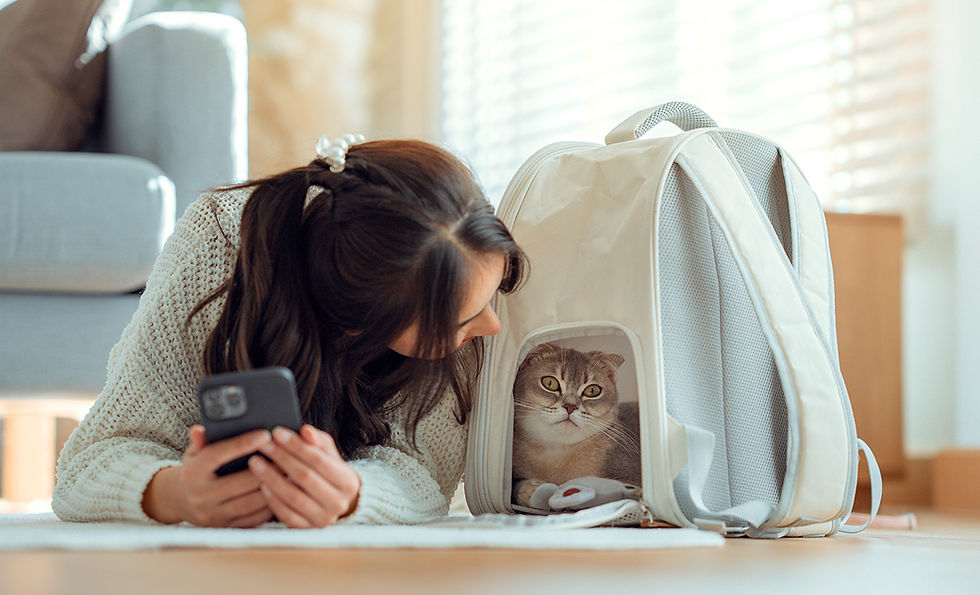- VEG
- Sep 19
- 3 min read
Depending on the part of the world you live in, the Autumn and Winter seasons promise shorter days. Less sunlight leaves many pet owners heading out for evening walks in twilight or complete darkness.
Your nightly dog-walking routine can come with hidden risks. Poor visibility makes it harder for drivers, cyclists, and even other walkers to see your pup, increasing the chance of accidents. Wildlife is also more active at dusk, raising the odds of a surprise encounter with a skunk, deer, or even a snake rustling in the leaves.
The good news? With a few precautions, you can help keep both you and your dog safe, visible, and confident on every nighttime walk. Read on for some bright ideas on dog walking safety at night!

Dangers of Walking Dogs in the Dark
What makes nighttime and twilight hours a treacherous trek? The risks of walking your dog at night increase for a few reasons. Remember these facts before you leash up for a leisurely lap:
Dangerous drivers while dog walking
Even well-meaning drivers may simply not see you or your pet in time to stop. Add in distractions, fatigue, and poor visibility, and the road becomes a very different place at night. Here’s why:
Rush-hour rage
Evening drivers hurrying home are often impatient or aggressive.
Tired drivers
Driving while tired causes drivers to react slowly, causing more accidents.
Night vision
Many don’t realize their vision is compromised in low light and drive without visual assistance.
Nocturnal nature—what creatures lurk?
The natural cadence of much wildlife is to come alive at night. Predators hunt in darkness, at a time when humans are less likely to be encountered.
Prowling predators
Coyotes, bobcats, bears, bats, owls, and foxes are most active at night and during twilight hours (dawn and dusk), posing wildlife dangers for dogs they encounter.
Wildlife watchouts
Even non-predatory animals can put your dog at risk. Deer and rabbits are more active, so if your dog has a chase instinct, it can make walks riskier. Skunks and raccoons hiding in leaves or trash cans or snakes concealed in the dark can also turn a walk into a worrisome one.
Walkway hazards
At night, debris, uneven pavement, or low-hanging branches are harder to spot and can lead to injury.
Still, all pet parents must deal with realities, whether early sun-sets make an evening walk in darkness, or sick dogs need to be taken out late at night. You won’t be left out in the dark! Read on for dog safety tips for night walks. And remember to keep your nearest VEG vet hospital in your contacts in case of emergency during your dog walk.

Tips for Safer Dog Walking at Night
It’s not all darkness and gloom, let’s shine a light on pet visibility tips that keep your autumn and winter walks safe for you and your pets.
Visibility is key to safety
Wear reflective gear
Pedestrians are way more visible to drivers when wearing reflective gear. Consider adding a vest, ankle and wrist bands, along with reflective gear for dogs, like reflective collars.
Bring a flashlight
Flashlights and headlamps help you see, while reflective gear helps you be seen. Using both makes every walk safer. Plus, carrying a light and making noise can help keep wildlife away.
Use LED lighting
Red lights are easier for the human eye to detect at night. Many LED dog-walking lights clip on, so you can add it to your pup and a red light for yourself. This helps drivers and cyclists spot you faster. No LED dog walking lights? Red cellophane or even a red marker over a flashlight works in a pinch.
Keep phone free
Definitely bring your cellphone but keep it tucked away so your attention is on your dog and your surroundings. Staying alert will help you to better detect wildlife and other nighttime dangers.
Stay on trusted trails
Stick to well-lit paths you know. Keep your dog leashed and avoid brush, leaf piles, or areas where wildlife is more active.

Keep VEG in your contacts in case of pet emergency
Darker days don’t mean your routine has to end. With a few safety tools and habits, pet parents can lower the risks and keep walks enjoyable. And remember, the lights are always on at VEG, open 24/7, so if your pet runs into trouble at night, our top emergency vets and highly-trained staff are here whenever you need us. Find a VEG near you.




